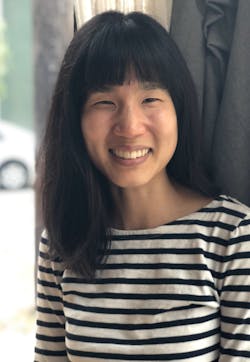2019 40 Under 40: Doris Lee
- One word to describe yourself: Conscientious
- Alma Mater: New York University
- Favorite hobby(s): Yoga and running
- Favorite route you have ever ridden or frequent (and why): My favorite route that I’ve ever ridden is the Powell/Hyde cable car in San Francisco (that stops right at the top of the iconic Lombard Street) because it’s the most nostalgic to me. The sheer glee and excitement of riding the cable car as it ascended and descended the hills of San Francisco is one of my earliest and most vivid memories of riding transit as a child.
Doris Lee always had a strong interest in mobility and how people move through different spaces—having grown up in Los Angeles, lived in New York City and now in San Francisco. In her seven-year career at WSP USA, she has helped more than two dozen public transportation agencies across the country provide safe and reliable transportation systems.
Her work with these transit agencies and other transportation stakeholders (including state DOTs, airports and the Federal Highway Administration) has centered around solving critical problems spanning multiple areas. She has helped prepare practical long range and strategic plans that have enabled agencies to have clear and defensible priorities, improve business processes to significantly improve efficiencies, plan for new asset management systems and select asset management systems.
Recently, Lee helped several transit agencies with preparing a clear roadmap for their asset management improvements, charting their improvement journey for years to come and doing it in a way that can be understood by a wide group of stakeholders. These plans had to be completed within a tight timeframe to ensure compliance with Federal Transit Administration’s (FTA) Final Rule for Transit Asset Management (TAM). Her easy-to-approach demeanor and capacity to distill complex topics into simple messages ensured that her recommendations are widely accepted within the agencies and put into practice. The plans innovatively included infographics and summary sheets to ensure higher visibility and were supported by detailed lifecycle models that provided underlying analysis.
Lee has also co-authored a multitude of guidance documents for state DOTs that have advanced the state of practice. These include guides to leverage technology to improve the project delivery and right of way management processes.
Outside of work, Lee is very active with Women’s Transportation Seminar (WTS), helping others in an industry that has historically had an under-representation of women. Lee is the co-chair of the Annual Event Committee for the WTS San Francisco Bay Area chapter and has helped raise more than $200,000 for the WTS Foundation, which helps fund scholarships for high school, undergraduate and graduate women interested in pursuing a career in transportation.
“I’ve always had a fascination with mobility and with cities. I grew up in Los Angeles where the mobility culture was very car-centric but spent much of my twenties in New York City where it was possible to get around without having a car. Living in New York City intensified my interest in mobility and opened my eyes to how important transit is as not only as a mode of travel, but also its role in confronting environmental sustainability, providing economic benefits and contributing to the vibrancy of cities.”
“I enjoy the problem-solving aspect of my job and helping clients grapple with and solve challenges that not only impact their organization but ultimately the rider experience. I also enjoy working with my brilliant colleagues who are so very passionate about what they do and who have been incredible mentors that have taught me so much about the industry and about myself.”
“The public transit industry is experiencing a surge of change and innovation and I enjoy that there are always new challenges to solve as trends change and disruptors are introduced to the industry. The intersection between cities and transit is an exciting space to work in, especially as it continues to evolve—and the opportunity to help define what the future of that intersection will look like is something I’m really passionate about.”
